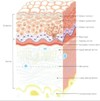As a specialist in facial rejuvenation, I’m often asked by patients what product they can use to keep themselves looking young. They typically ask about special creams, ointments, and serums.
My answer to them is that the best thing people can do simply to wear sunscreen daily; it’s one of the best ways to keep a person looking young.
Recent research from Australia supports this advice I’ve been giving my patients over the years. I thought it would useful for readers of this blog for me explain a bit about this research, sun exposure, Ultraviolet Rays, and how the sun affects us as we age.
First: A Few Facts About Our Skin
We often think of our lungs, liver, and intestines when we think of organs, but our skin is actually the largest organ of our body, and it plays many roles.
The skin’s first role is protection. It protects us from infections, maintains our body temperature, and is a barrier to keep chemicals out of our bodies. It also acts as a fluid barrier, keeping our own body fluids in and outside environmental fluids out. It’s our primary source for sensory input and helps us feel our way through the world. Finally, it helps make Vitamin D for our body when exposed to the sun.
The skin is made up of a few major layers. The first is the epidermis. This is the top layer of the skin and is composed of dead cells on the outer layer of our skin plus a critical living cell layer called the basal layer on the inside.
The basal layer is responsible for all of the skin layers above itself. If this basal layer is healthy, then the rest of the epidermis is healthy. If it’s not healthy, then the rest of the epidermis will show damage and disease.
The next major layer is the dermis. This is a deeper level of the skin, and the layer where our collagen and elastic fibers lie. It’s also the layer that glands, some pigments cells, and hair follicles travel though. The dermis gives our skin its suppleness and strength.
So How Does Our Skin Age?
The first way our skin ages is through the simple passage of time. We call this “intrinsic aging,” and it is normal aging related to our genetics.
The other way is through what we call “premature aging.” Factors that lead to premature aging include photo aging from the sun, smoking, stress, diet, topical products, pregnancy, and hormonal changes.
Of all of the factors affecting the aging of our skin, the biggest is photo aging, or aging of the skin due to exposure to the sun. And the single best way to help prevent skin from this aging is through sun protection. It’s been estimated that 90% of all wrinkles, age spots, and skin discoloration is due to sun or tanning bed exposure.
The ABCs of UV
In order to properly protect ourselves against the sun, it’s important to understand exactly how the sun affects our skin.
When the sun shines down on the earth and warms us, it contains a number of different types of light rays. Visible light is the most obvious as it allows us to see, but another type of light ray is invisible yet very damaging to us. These are the Ultraviolet (UV) rays, which themselves can be broken down into several parts.
The first type of UV rays are UVA rays. UVA rays accelerate skin aging. They have a long wavelength, which allows them to penetrate deeply into the skin through the epidermis and down into the dermis, where it can fracture collagen and elastic fibers. These rays are present all day long, from sun up to sun down—they even have the ability to penetrate clouds and car windows.
The next type are UVB rays. These cause redness in the skin and are responsible for sunburn. They are most prevalent from 10:00 a.m. to 4:00 p.m. and have a shorter wavelength that can’t penetrate as deeply into the skin.
The last type are UVC rays. These are toxic to life and absorbed by the ozone layer.
The Importance of Sun Protection
SPF (the number you see on your sunscreen bottles) is an acronym for Sun Protection Factor. It primarily measures protection against UVB rays, but new guidelines are helping consumers understand whether products help against UVA rays as well. This is very important as it’s critical for us to use sun protection products that block both UVA and UVB rays.
And we should not be protecting ourselves only on certain occasions; incidental exposure matters! Every moment that our skin is exposed to the sun, its radiation is creating some skin damage. Skin damage from the sun doesn’t just occur when you’re spending a day at the beach; it also occurs when you’re walking from your home to your mailbox or driving your car.
To help protect our skin, it is critical to wear sun protection every day on all exposed areas of our skin. Sun damage is cumulative, and years of daily small sun damage can add up to a much older appearance and a greater amount of damage to skin.
Take a look at these examples of UV exposure over time:
This first woman is only 58 years old. She worked in the sun most of her life, and her skin reflects this exposure.
Notice the difference in the qualities of their skin. This is what happens with daily sun exposure over time.
The next example is equally striking. This person is a truck driver, and over his career, one side of his face has always been facing the window, where the sun would come through and warm his cheek. Remember how I mentioned that UVA rays can penetrate car windows?
After years of driving a truck, this man has visibly different levels of skin aging on the two sides of his face as a result of his UVA exposure over time:
Using computers, we can superimpose the left and right sides of his face and create the following two examples. The first picture is what this man would look like if both sides of his face matched the less exposed skin on his right side:
The next is what he would look like if his entire face had the more exposed skin currently on his left side:
Notice the big difference in how we perceive his age between these two pictures. Sun exposure really matters!
What the Australia Study Means
The research, done at the Queensland Institute of Medical Research and published in the journal Annals of Internal Medicine, studied 900 men and women over the course of 4 years. One group used regular sunscreen daily and the other used it occasionally. Those who used it daily, as I have been suggesting for years, experienced 24% less skin aging than those who only used it sporadically.
These results have more significance than simply preventing skin aging. The same sun exposure that ages our skin also contributes to skin cancers. Protecting our skin from the sun doesn’t just help us look younger; it also helps us stay healthier by reducing our chances of skin cancer.
I have many ways that I can reverse sun damage using my laser skin resurfacing procedures
(see below), but it’s always best if we can prevent sun damage in the first place.
For more information on this procedure, and others we perform to help our patients restore, reveal and reclaim their natural beauty, please visit https://source.adamscheinermd.com.








